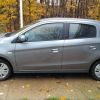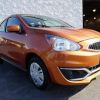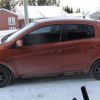Yes, I asked the dealer and he said "The recommendation is no ethanol in small engines. Ethanol tends to leave residue and gunk things up over time."
And:
"If you must use Ethanol, I would research whether there is a specific additive that minimizes the effects of the ethanol. We recommend Sta-Bil in the tank if the bike will sit for extended periods, and if the bike is going to sit, I would not leave any ethanol fuel in it. I would not use an ethanol fuel unless there is no other option in an absolute pinch.
Premium fuel is fine, but you can run as low as 87 octane and not hurt anything. I did find a Sta-Bil Ethanol treatment on Amazon.com. They make varying quantities, so you can choose what best fits your need." I presume they meant 87 with 0 ethanol.
Carburetors are even less capable at handling ethanol. I hope that my town still has a no-ethanol station- I was never picky about this before, but would hope that motorcyclists could still have access to this- kinda defeats the whole "route 66" road trip idea but it seems some modern motorcycles are capable of it.
https://www.motorcyclistonline.com/g...t-magazine-mc/ Another thing is 10% ethanol is 10% "green" fuel but with a 100mpg tank I feel like I've "earned" my E0 access at 5x the fuel efficiency of most pickups. This website seems fairly up to date
https://www.pure-gas.org/extensions/maps.jsp
Edit: Interesting: "Assuming your bikeÂs capacity is 4 gallons, the 15-foot hoseÂs 0.24-gallon volume is only 6 percent of the tankÂs capacity. For the more common 10-foot hose itÂs just 4 percentÂin other words, negligible. And thatÂs assuming the hose is completely full from the manifold to the nozzle valve, which it may not be."
The Navi has a 0.9 gallon tank, which a .24 gallon hose with a previous vehicles fuel selection would comprise more than 26.6% of the fuel- assuming it is 15% ethanol and not 85% ethanol and sharing the same hose. That would work out to about 3.75% ethanol starting from an empty tank, with the first .24 gallon 15% ethanol and the remaining 0.66 gallons 100% E0 (assuming it is an option but without a separate hose). Seems like still a lot more ethanol than some engines can handle..


 My Mirage
My Mirage

 Reply With Quote
Reply With Quote
 2019 Mitsubishi Mirage ES
2019 Mitsubishi Mirage ES

 The Pumpkin
The Pumpkin


